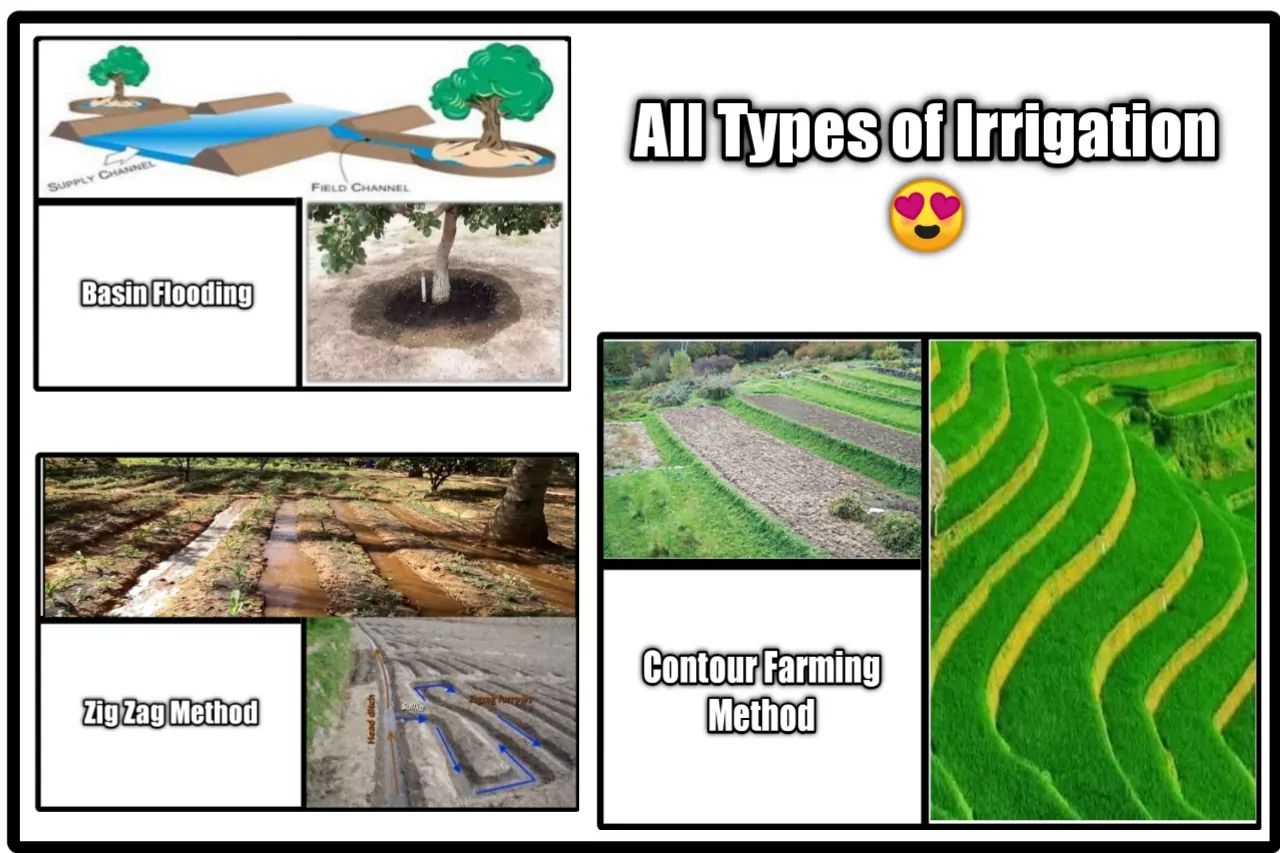Irrigation is defined as the process of artificially supplying water to the soil for raising crops. So for proper providing irrigation, we need to study various types of irrigation.
Irrigation water may be applied to the crops by three basic methods:
(i) Surface irrigation methods
(ii) Sprinkler irrigation methods
(iii) Sub-surface irrigation methods
The various types of irrigation are indicated below :

How To Choice Types of Irrigation :
1) Factors affecting the selection of types of irrigation methods :
- Soil characteristics of the land to be irrigated.
- The topography of the area
- The available water supply
- Type of crop and its water requirements
- Size of the stream supplying irrigation water
- Rate of infiltration of the soil
- Depth of the water table
- Depth of the root zone of the plants
- Amount of water required in each irrigation
- Possible erosion hazard of soil
2) All types of irrigation should fulfil the following objectives :
- The method of irrigation should be such that an adequate amount of water is stored in the root zone of the plants.
- The method of irrigation should ensure a uniform application of water.
- The method of irrigation should not cause soil erosion problems.
- The method of irrigation should be efficient, with minimum wastage of water. 5. The method should not be expensive
- The method of irrigation should be such that the land is not wasted for constructing field channels, borders, etc.
- The method of irrigation should be suitable for use with an economical conveyance structure.
- The method of irrigation should fit properly to the boundaries of the land to be irrigated.
- The method of irrigation should not be inconvenient and difficult.
- The method of irrigation should not cause waterlogging in the irrigated land.
Surface Irrigation Methods:
In the surface irrigation methods, the irrigation water is applied by spreading in the form of sheets or small streams on the land to be irrigated.
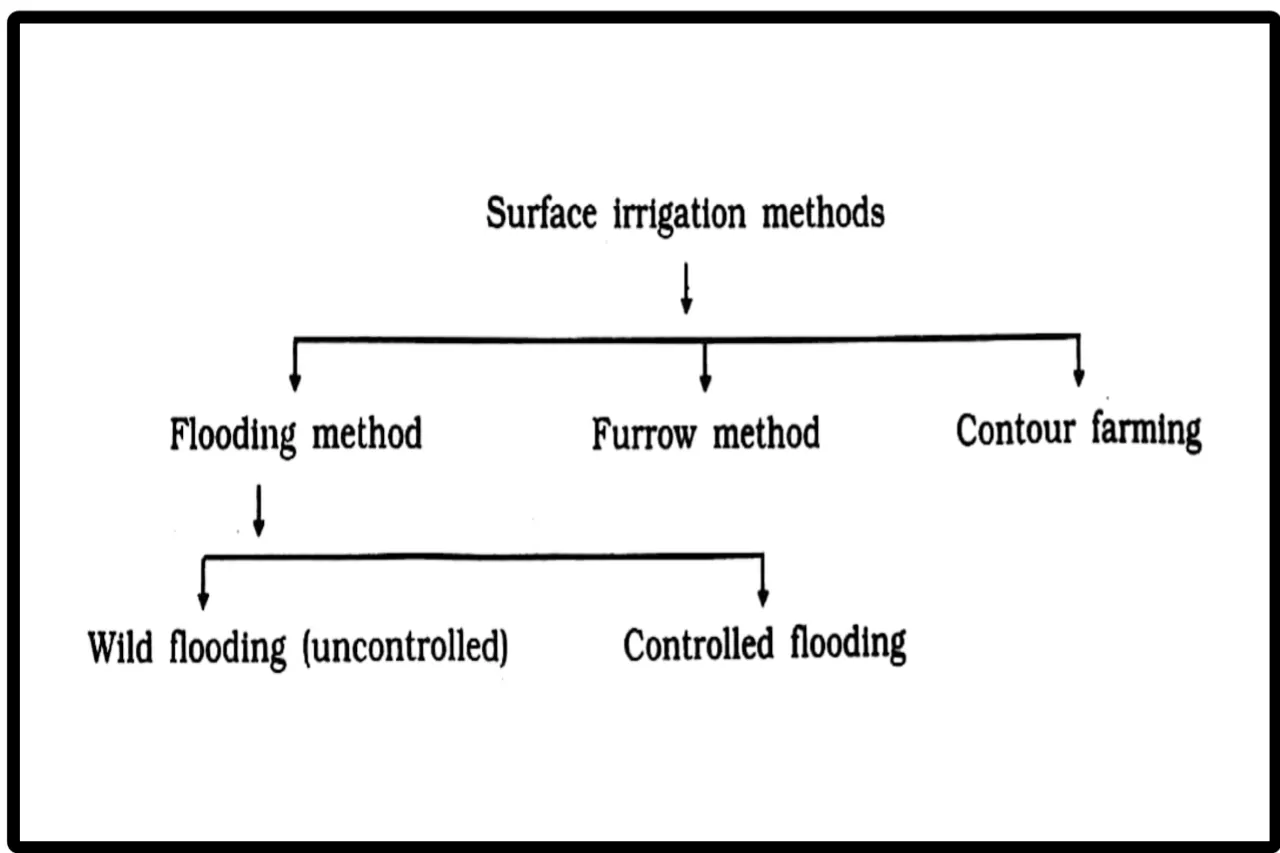
All the above methods of surface irrigation are adopted for the perennial irrigation system. The inundation irrigation system adopts only the wild or uncontrolled flooding method of irrigation.
A) Wild flooding or uncontrolled flooding :
These types of irrigation are the earliest and primitive methods of the application of water to the land. In this method, water is applied by spreading it over the land prior to the application of water, no land preparation is done in the form of levees (or borders) or field ditches. The water is allowed to flow the natural slope of the land. There is no control over the flow of water, as there are no levees to guide water.
In these types of irrigation method, water may be applied to the land directly from the natural stream or river during floods, as in the case of inundation irrigation system. Alternatively, the water may be applied to the land from the field channels or the watercourses as in the case of the perennial irrigation system.
These types of irrigation are suitable for smooth and flat land for which no preparation of the land is normally required. In such a case, a somewhat better water application is achieved. Moreover, this method of irrigation is well adapted to the lands that have such irregular surfaces that the other irrigation methods are impractical. However, this method of irrigation involves a wasteful use of water and hence it is practiced only where water is available for irrigation in abundance and it is inexpensive
B) Controlled Flooding :
In these types of methods, irrigation water is applied by spreading it over the land to be irrigated with proper control on the flow of water as well as on the quantity of water applied. All the methods of control flooding require prior preparation of the land. The land is properly graded and the agricultural fields are divided into small units by levees and the field channels are excavated.
The various methods of controlled flooding are :
- Free flooding
- Contour laterals
- Border strips
- Checks basin
- Basin flooding
- Zig-zag method
1. Free Flooding :
These types of irrigation methods consist of dividing the entire land to be irrigated into small strips by a number of field channels or levees, known as laterals. These laterals (field channels) may be either at right angles to the sides of the field or at right angles to the contour lines, as shown in the figure.
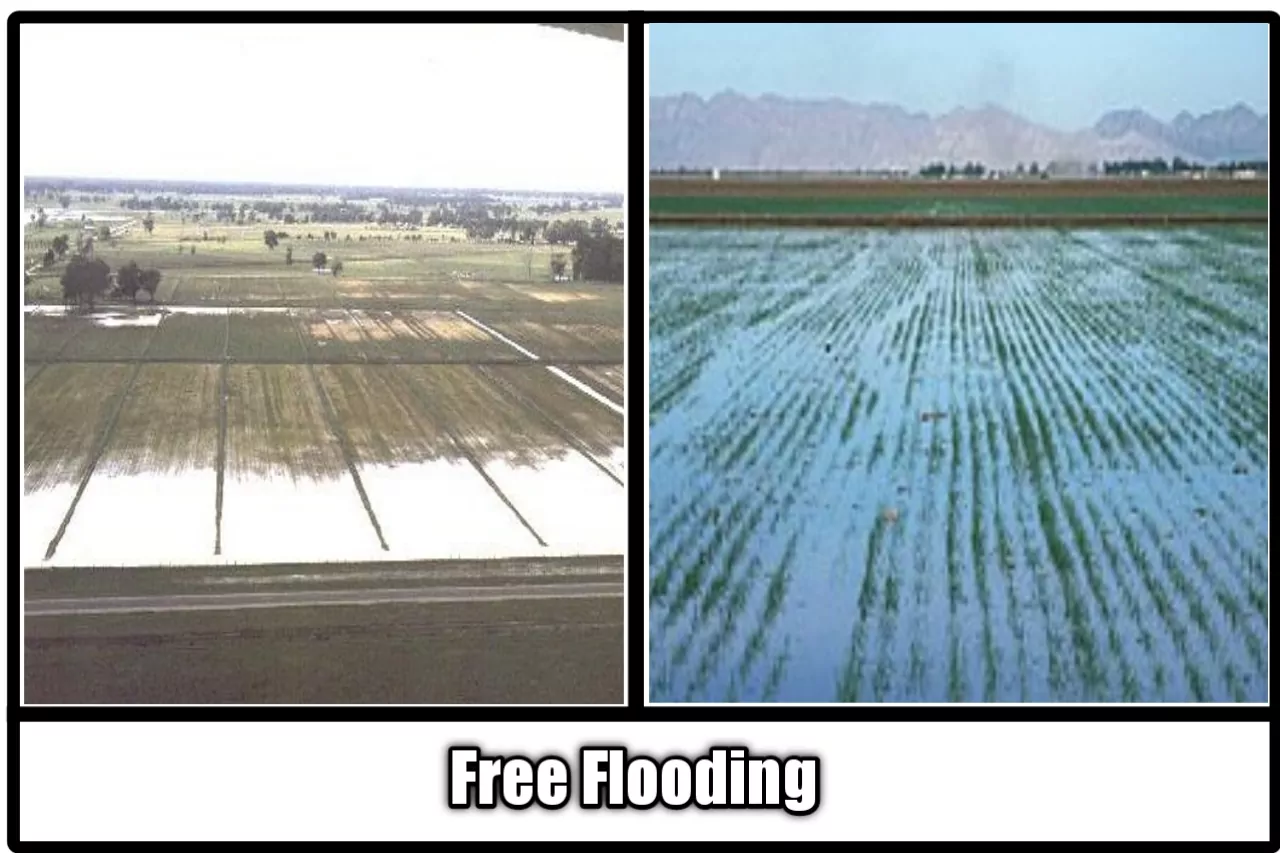
When laterals are aligned at right angles to the sides of the field, irrigation is possible only to one side of the lateral. However, when the laterals are aligned at right angles to contours, irrigation can be done to both sides of the lateral. The field channels receive water from the supply channel and discharge excess water in the waste channel.

These types of methods can be used both for flatlands as well as for relatively steep lands. The alignment and spacing of the laterals depend upon the type of soil (i.e. permeability of soil) and topography of the land. If the slopes are steeper closer spacing of laterals is required. For flat land and for relatively less pervious soils, the spacing of the laterals may be increased. Normally the spacing of the laterals may vary from 10 to 50 m.
2. Contour Laterals :
This is a special case of free flooding in which the field channels or laterals are aligned approximately along the contour lines.

In these types of irrigation methods, irrigation is possible only on one side of the laterals. This method is applicable* for steeper terrain. The spacing of contour laterals depends upon the slope of land and type of soil.
3. Border Strips :
In this type of irrigation border strip method, the agricultural farm is divided into a series of strips 10 to 20 m wide and 100 to 300 m long. These strips are separated by low levees or borders. These strips have uniform slope along the direction of flow, but there is no cross slope. Therefore, when the water is applied at its end, it spreads over the entire width as it flows down the slope along the longitudinal direction.
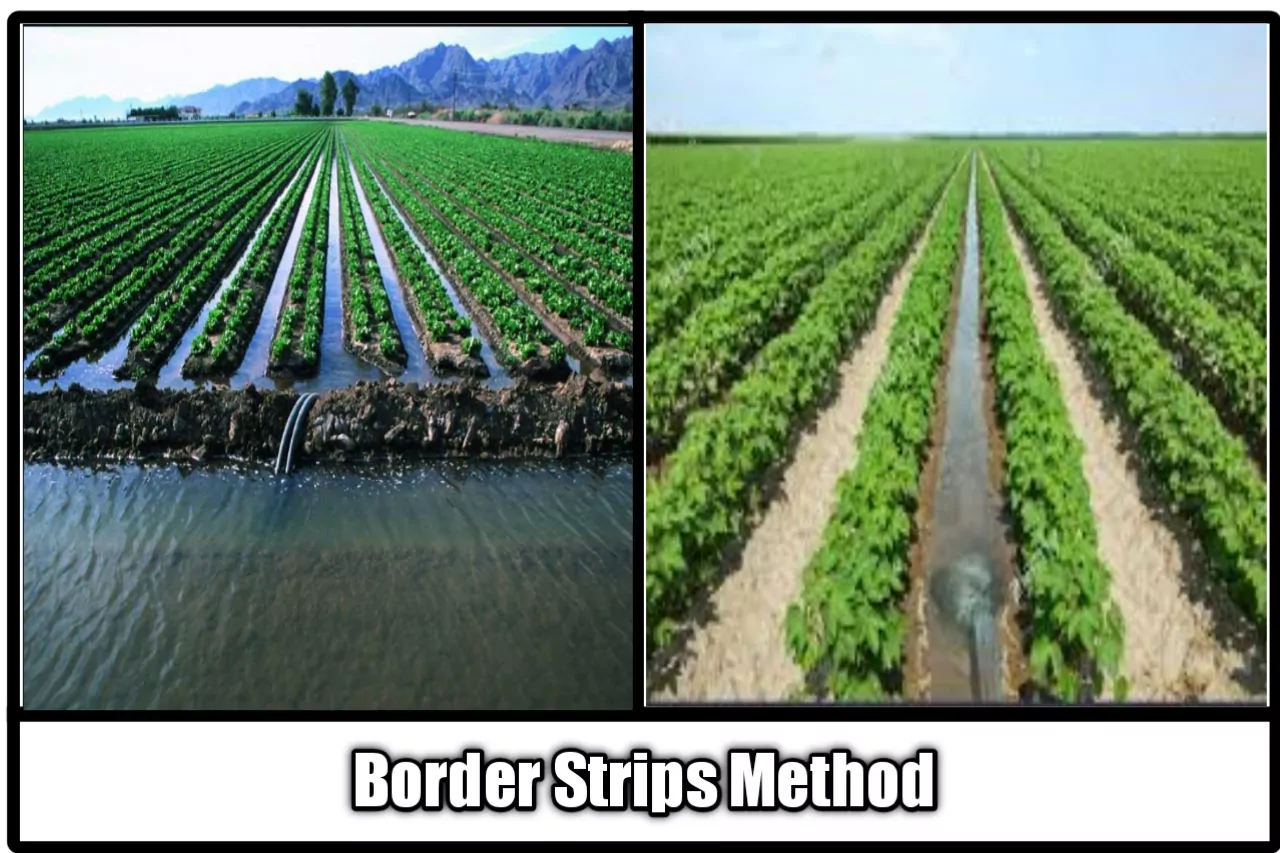
Conditions favorable for the border strip method :
- These types of irrigation method are suitable for irrigating all close-growing crops except rice.
- The method is suitable for soils of wide variations in texture.
- The method is best suited for land having a slope less than 0.5% (i.e. 1 in 20)
- The method is best suited for soils having low to moderate intake rates.
Advantages :
- If the strips and borders are properly designed, a good water – application efficiency can be achieved.
- The labour requirements are less.
- If the surface drainage is poor, the method is ideal for rapid disposal of excess water.
Disadvantages :
- A stream of relatively large size is required to irrigate a strip of a practical size.
- The cost of leveling is relatively high unless the topography is relatively smooth.
- It is difficult to apply a depth of water less than 5 cm.

The supply ditch, also called irrigation stream may either be in the form of an earthen channel or a lined channel or an underground concrete pipe having risers at intervals. The size of the supply ditch depends upon the infiltration rate of the soil and the width of the border strip. Coarse textured soils with high infiltration rates will require a high discharge rate and therefore larger supply ditch. On the other hand, fine-textured soils with low infiltration rates, require smaller ditches.
4. Checks basin or check flooding :
These are the most common types of irrigation used in India as well as in many countries of the world. This method is also known as the method of irrigation by plots.
In these types of irrigation, the land to be irrigated is divided into small plots or check basins surrounded by checks or levees as shown in fig. 3.4. Each plot or basin has a nearly level surface. The size of the levee depends upon the depth of water to be applied as well as the stability of the soil when it is wet.

Water is conveyed to the land by a system of supply channels (main ditch) as well as laterals (known as field channels). Usually there is one field channel for every two rows of plots.
Water is admitted to these plots at the higher end and the supply is cut-off as soon as the lower part of the plot has received a sufficient depth of water. Oblong plots are preferred to the square plots. The size of the plots depends on the porosity of the soil. For the soils which have high porosity and filtration rate, the size of the plot is small.

For medium soils and for most crops, the area of the plot is between 400 and 500 m2. However, the area of the plot may be as small as 1 m2 for growing vegetables and other intensive cultivation crops. On the other hand, it may be as large as 104 m2 (=1 ha) for growing rice under wet conditions.
5. Basin flooding :
These types of irrigation methods are also known as the ring basin method. It is a special form of check basin method of irrigation, which is used for the irrigation of orchards (enclosures with fruit trees). In this method, for each tree a separate basin is made which is usually circular in shape and hence it is known as ring basin method. However, in some cases basins of large size are made to include two to five or more trees in one basin.
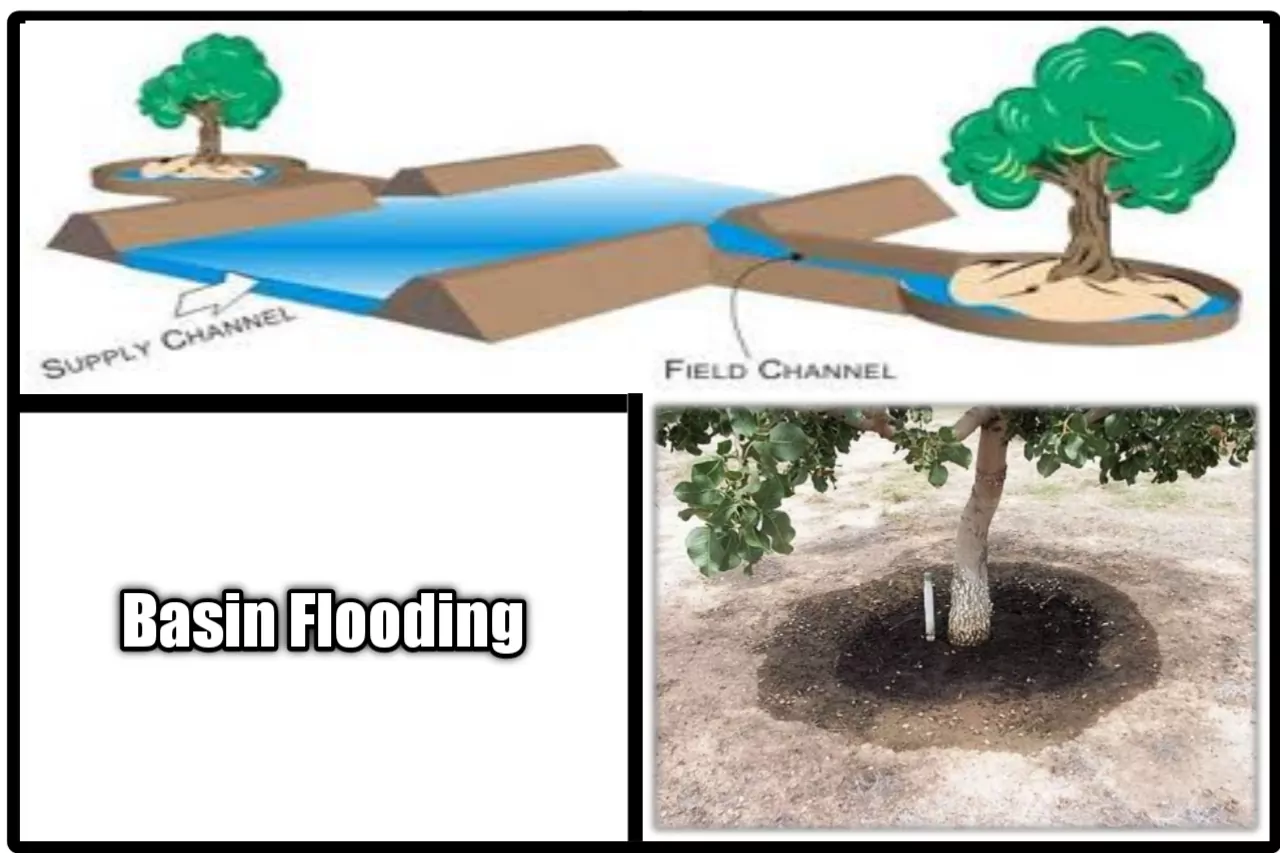
Water is supplied to the basins from a supply channel through small field channels connecting the basins with the supply channel. In most of the cases, each basin is provided with a separate field channel. Portable pipes and large hose pipes are also sometimes used instead of field channels.
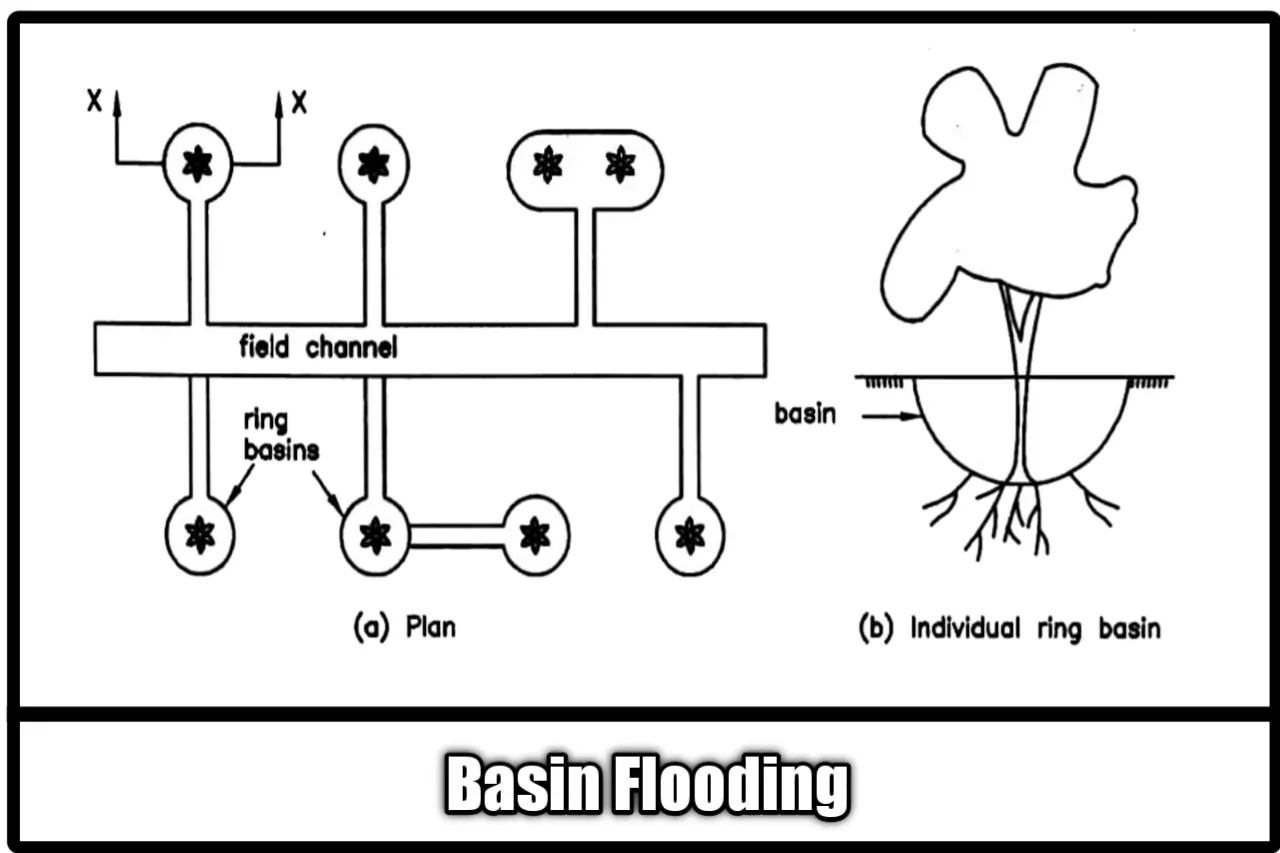
6. Zig-Zag method :
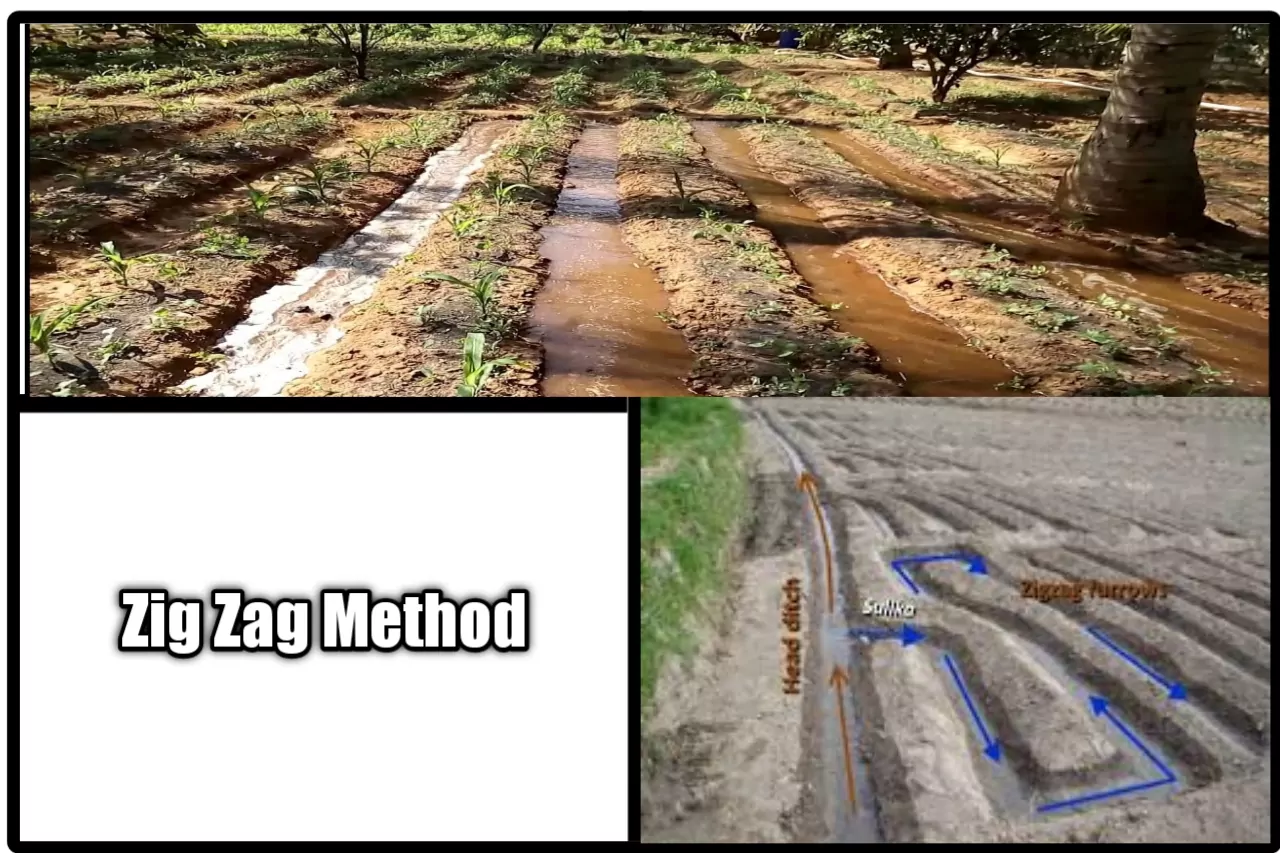
These types of irrigation is a special method of controlled flooding where water applied to the land takes a circular route, starting from the field channel and reaching the dead end of the plot. For this purpose, the whole farm is divided into a number of square or rectangular plots. Each plot is provided with levees (or small bunds) such that the water takes the circuitous path covering the entire plot.

This method is suitable for relatively level plots. However, the method is not suitable when the farming operations are to be done with modern farm machinery.
C) Furrow Method :
In these types of irrigation method, water is applied to the land to be irrigated by a series of long, narrow field channels called furrows which are dug in the land at regular intervals. It’ may be noted that water is not spread over the irrigated field. The water flowing in the furrows infiltrates the soil and spreads laterally and reaches the roots of the plants between the furrows.

In the flooding methods, as discussed earlier, the entire land is wetted directly by the water, whereas in the furrow method, only a part of the land is wetted. The wetted area usually varies from 1/5 to 1/2 of the total area. It helps in reducing the evaporation losses and achieving high water application efficiency.

These types of irrigation are commonly used for row crops such as maize, jawar, sugarcane, cotton, tobacco, groundnut, potatoes, etc.
Types of Furrow :
On the basis of alignment, the furrows may be classified into two types.
(i) Straight furrows
(ii) Contour furrows
(i) Straight furrows :
Straight furrows are used where the land slope is nominal. These are aligned more or less along straight lines, parallel to each other, and along the slope of the land. These furrows are best suited where the land slope does not exceed 0.75%.
(ii) Contour furrows :
These are the furrows that are aligned along the contours and hence these are laid across the slope of the land. These furrows are therefore curved in plan and are usually adopted where the land to be irrigated has a relatively steeper slope.
Advantages of furrow irrigation :
- Low evaporation losses as only 1/5 to 1/2 of the irrigated land surface is wetted.
- It is suitable for row crops such as maize, jawar, sugarcane, cotton, tobacco, groundnut, potatoes, etc.
- It is suitable for those crops (like maize) that are injured by contact with water.
- No wastage of land in field ditches.
- Fairly efficient in the use of water.
- Relatively cheap to construct and maintain.
- It is possible to cultivate earlier in heavy soils.
- Furrows serve as drainage ways for surface runoff in areas of heavy rainfall.
- Labor requirements in land preparation and irrigation are very much reduced.
Disadvantages of furrow irrigation :
- Not recommended for very light soils having high infiltration capacity.
- Ditches may interfere with tillage.
- Usually expensive from the consideration of time labour cost.
- Serious erosion hazard
- Adequate drainage needs to be provided.
D) Contour Farming :
Contour farming is practiced in hilly regions where the lands to be irrigated have steep slopes. It also controls erosion due to rainfall. In this method, the land to be irrigated is divided into a series of strips aligned along the contours. These strips are also known as terraces or benches.

The vertical interval between two successive strips is usually 30 to 60 cm. Thus a series of steps is formed around the slope. Each strip forms an independent portion of the land to be irrigated.
The strips do not have any cross slope in the direction of the land slope. However, they are given a gentle slope along their length to ensure efficient irrigation and the drainage of excess water without causing erosion.
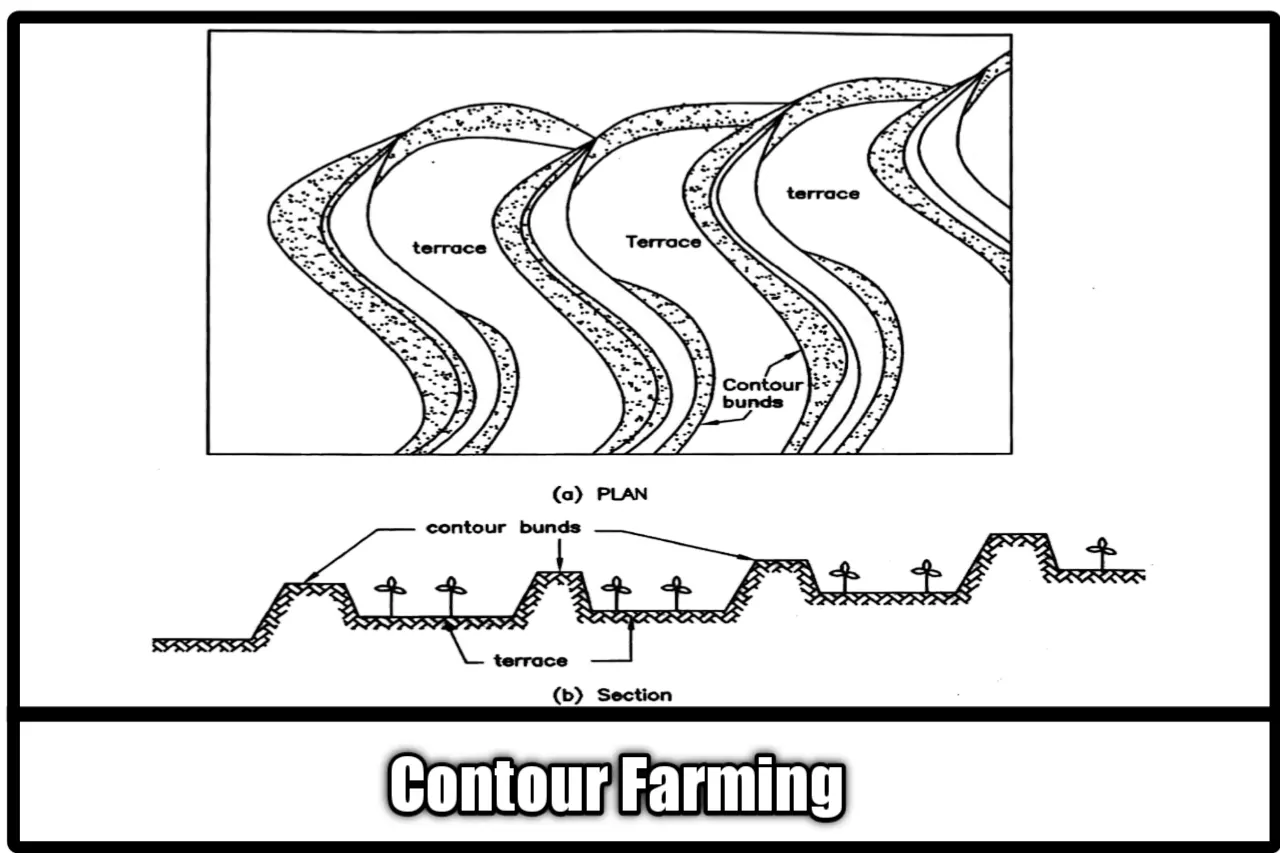
At the outer side of each strip, a low levee or dyke (or bund) is constructed which follows the boundary configuration along the contour. The height of the bund should be sufficient enough to contain irrigation water as well as surface runoff due to rainfall. For applying irrigation water to the strips any of the methods such as border strips, furrows, and check basins can be used.
Sub-Surface Irrigation Methods :
The sub-surface irrigation methods consists of supplying water directly to the root zone of the plants.
The favorable conditions for the sub-surface irrigation practice are :
- Adequate drainage needs to be provided.
- Impervious sub-soil at reasonable depth (at 2 to 3 m)
- Moderate slopes
- Uniform topographic conditions
- Permeable soil such as loam or sandy loam in the root zone of the soil.
- Good quality irrigation water
The subsurface irrigation methods can be classified as follows :
- Natural sub-surface irrigation
2. Artificial sub-surface irrigation
3. Drip (or trickle) irrigation
1. Natural Sub-Surface Irrigation :
In these types of irrigation, water is supplied to the root zone of the plants by controlling the level of the local water table. Such a high level of water table in the area may be available due to water seeping from canals, drains, lakes, rivers etc. and hence natural subsurface irritation occurs.
In order to ensure an adequate supply of water to the crops, it is essential to maintain the water table near the roots of the plants. For this purpose, a series of parallel channels with almost vertical sides are excavated in the land to be irrigated. The channels are spaced 15 to 100 m apart depending on the permeability of the subsoil and the topography of the land to be irrigated.

The depth of the channels varies from 0.3 to 1 m and their width varies from 0.25 to 0.5 m. These channels are known as Seepage channels.
The seepage channels have a relatively flat bed slope so that the velocity of flow is small. Thus these channels remain filled with water for a long period and adequate seepage occurs. The flow of water in the channels is regulated so that the adequate supply of moisture is maintained in the root zones of the plants by capillary action from the water table.
To prevent waterlogging, proper drainage of the excess water should be provided. If such conditions develop, the flow of water in the channels is reduced or sometimes stopped. The soil should be allowed to dry Just before harvesting.
Advantages :
- There is a saving in the labor cost for the preparation of the land.
- There is a good water distribution.
- There is proper control over the water supply to prevent waterlogging and salinity.
- There is an economical use of water.
- The crop yield is quite high.
Disadvantages :
- This type of irrigation requires an unusual combination of natural conditions, which are rare. If the conditions are not favorable, the method can not be used.
- Because the movement of water is upward from the water table, unwanted salts are deposited close to the land surface. Periodic leaching is required for removing the salts.
2. Artificial Sub-Surface Irrigation
The artificial sub-surface is the types of irrigation consists of applying water directly to the root zone of crops through a network of buried perforated pipes. Water is made to pass under pressure, through these underground perforated pipes. This method is suitable only for those soils formations which have high horizontal permeability to permit lateral movement of water and low vertical permeability

The pipes are buried 0.3 to 0.4 m deep so that cultivation operations are not hindered. For uniform distribution of water, the pipes are spaced 0.4 to 0.50 m horizontally.

Advantages :
- The water distribution is quite good.
- The method makes effective use of water.
- Evaporation losses are avoided, and percolation losses are also reduced.
Disadvantages :
- This type of irrigation method is very expensive because of the cost of pipes and the installation cost.
- The clogging of small perforations of the pipe usually occurs because of silt, sand and debris.
- The water used should be good quality and low salinity, because this method does not permit leaching.
Sprinkler Irrigation :
In these types of irrigation, water is applied to the land in the form of a spray. It resembles a light rainfall in the form of a drizzle. Sprinkler irrigation is also sometimes called overhead irrigation. The greatest advantage of sprinkler irrigation is its adaptabilities to use under conditions where surface irrigation methods are not efficient.

This method is more useful under following situations :
- The land can not be prepared for surface methods.
- Topography is irregular
- Slopes are excessive
- Soil is erosive
- Soil is excessively permeable or impermeable.
- The depth of soil is shallow over gravel or sand.
In this system, the cost of land preparation and permanent water delivery system of channels or conduits is less. However, there is a large initial investment in the purchase of the pumping and sprinkling equipment.
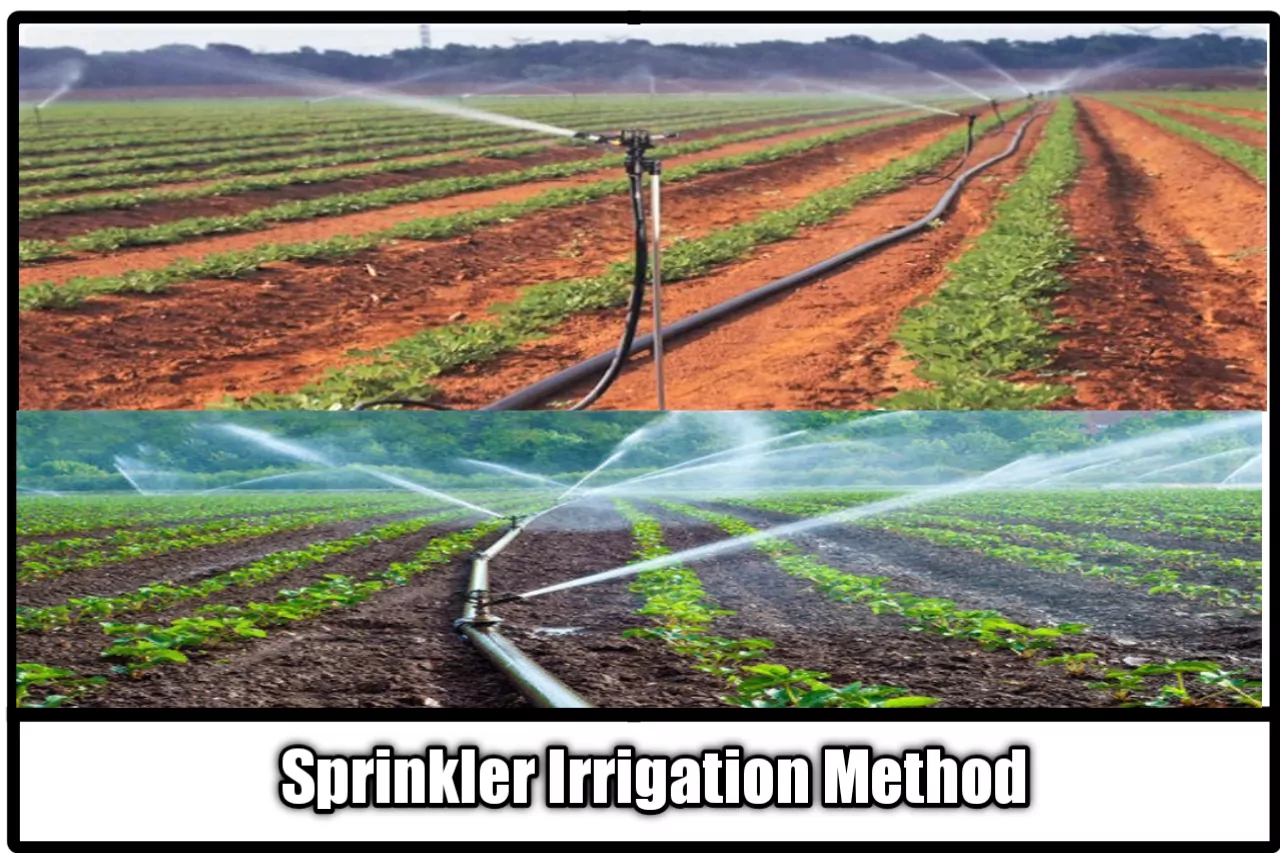
Components of a sprinkler irrigation system :
A sprinkler irrigation system consists of the following main components :
- Pumping unit
- Main delivery pipes
- laterals
- Sprinklers
- Other accessories
1. Pumping Unit :
• The pump lifts water from a water source and supplies it to the main pipeline. Normally, to lift water from a depth up to 5.0 m single-stage centrifugal pump is required.
2. Main delivery pipes :
- These are usually buried in the ground.
- They are made of concrete, asbestos, cement, G.I., plastic or C.I. The mains are laid at a depth 0.50 to 0.75 m below ground level.
- The diameter of mains varies from 5 cm to 15 cm.
3. Laterals :
- Lateral pipes are connected to the main pipelines.
- Sprinklers are fitted on the laterals with risers.
- These pipes are 50 mm in diameter and 6 m long.
4. Sprinklers :
- Sprinklers are mainly two types :
- Sprinkler with fixed head
- Sprinkler with rotating head
5. Other accessories :
- Special couplings
- regulating valves
- Pressure gauges
- bends, elbows, tees
- reducers, plugs, clamps, etc.
Sprinkler systems are mainly of three types.
- Fixed nozzle pipe
- Perforated pipe
- Rotating sprinkler
1. Fixed Nozzle Pipe :
The fixed nozzle pipe type of sprinkler consists of the lateral pipes having a line of small holes drilled at the top at some regular interval along their lengths and on each of these holes small nozzles are fitted. A series of such pipes are installed parallel to each other at a distance of about 15 m apart and are supported on rows of posts.

The spray of water is developed through the nozzles and the entire 15 m width between the pipelines may be irrigated by turning the pipes through 135°. This type of sprinkler was the early system. These days it is rarely used in practice.
2. Perforated Pipe Sprinkler :
In these types of irrigation, lateral pipes are perforated. The perforations (small holes) in the lateral pipes are drilled on the top surface and sides in a specially designed pattern to spray the water uniformly. The lateral pipes are placed on the land surface at a suitable spacing. When the water is supplied to the lateral pipes, it comes out the perforations in the form of a spray. The sprays are directed from both sides of the pipe and can cover a strip of land of 6 to 15 m width.
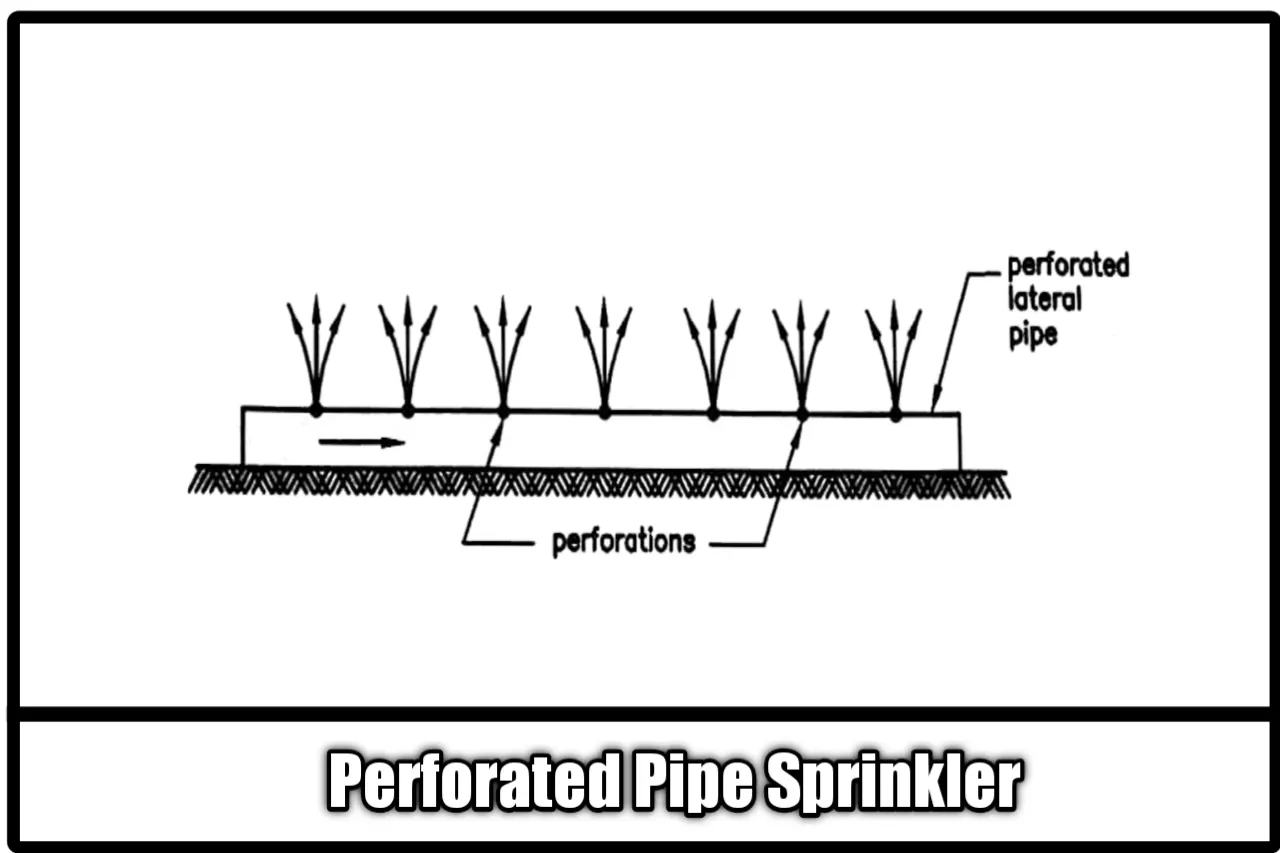
Fig. shows a perforated pipe. The rate of application of water is usually greater than 2 cm depth per hour. The operating pressure for these sprinklers is usually in the range of 50 to 250 kN/m2. This type of sprinkler system is generally used for the irrigation of orchards and nurseries.
3. Rotating Sprinkler :
The rotating sprinkler consists of one or two nozzles mounted on a body which is rotated slowly about a vertical axis by the action of a deflecting vane connected to it. The jet of water issuing from one of the nozzles impinges on the vane and thrusts it aside.
The rotating sprinklers are placed on the riser pipes and are located just above the crops to be irrigated. As such the height of the riser pipes depends upon the maximum height of the crop. However, the minimum height of the riser pipe is 0.3 m when the riser pipe is of 25 mm diameter and 0.15 m when it is of 20 mm in diameter.
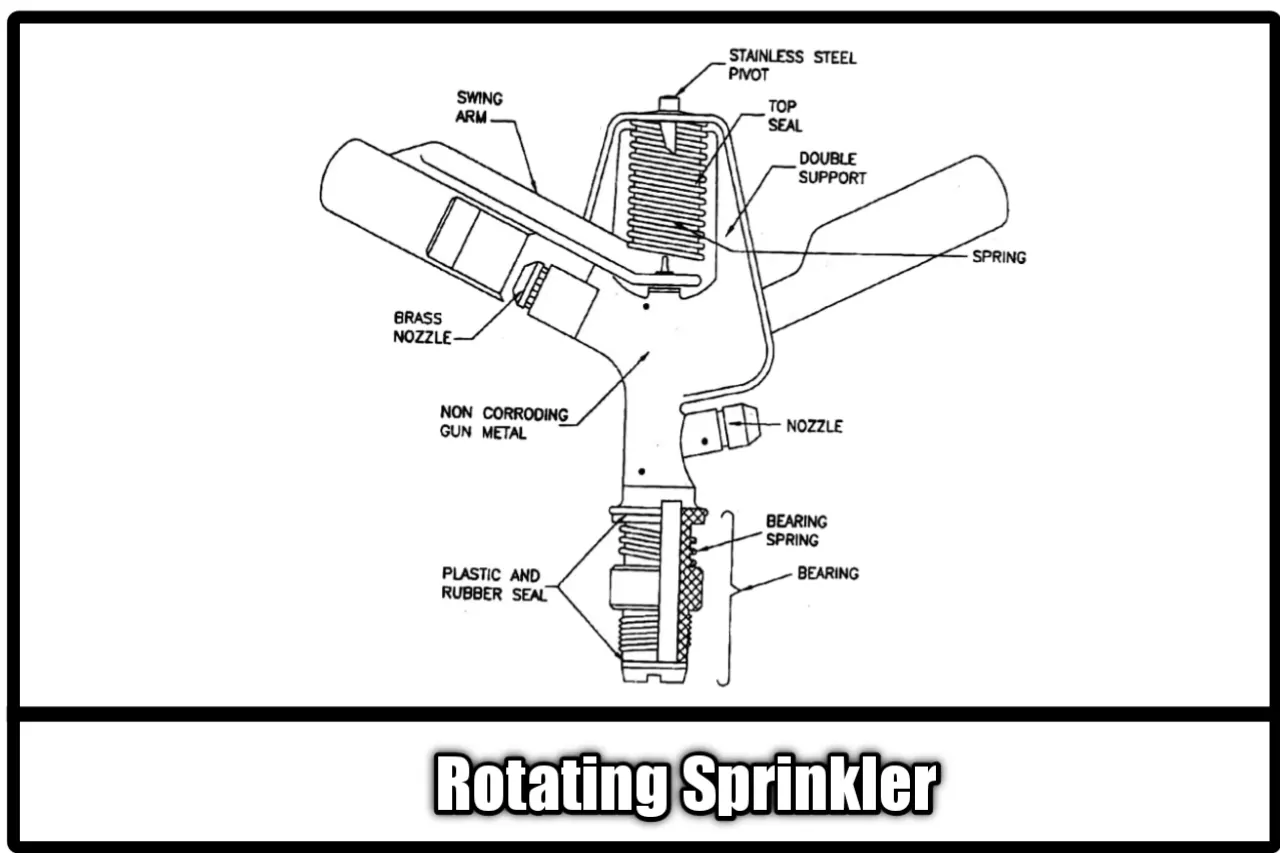
The riser pipes along with the sprinklers are fixed at regular intervals along the length of the lateral pipes and their spacing is so adjusted that the water spread areas of the adjacent sprinklers partially overlap with eachother in order to achieve uniform application of water.
The required discharge of each sprinkler depends upon the water application rate, spacing of the sprinklers along the lateral pipelines and the spacing of the lateral pipelines along the main pipeline.
Based on portability, sprinkler irrigation systems are classified into the following types :
- Fully, portable system
- Semi-portable system
- Semi-permanent system
- Solid-set system
- Permanent system
1. Fully portable system :
A fully portable system has the main pipelines, submarine pipelines, the lateral pipelines, sprinklers, and the pumping unit portable. It is designed to be moved from one agricultural field to another or to different pump sites in the same field. The -system can be moved manually or mechanically by mechanical power. The system operated manually is known as the hand move system.
In this system, the main pipeline and the lateral pipelines are separated and then moved manually. The system operated mechanically is called the wheel move system. In this system, the entire lateral pipeline set is mounted on wheels and is moved as one unit. In this system, the locations of the pumping unit and the water sources are not fixed.
2. Semi-portable System :
A semi-portable system is the modified form of the fully portable system, in which the locations of the water source and the pumping unit are fixed, but the main pipelines and the lateral pipelines are portable. This system can be used for irrigating more than one field if there is an extended main line to which portable lateral pipelines can be connected.
3. Semi-Permanent system :
A semi-permanent system has the portable lateral pipelines but the main and the sub-main pipelines are permanently laid and are usually burned.
Further, the source of water and the pumping unit is also fixed.
4. Solid-set system :
In this system, the lateral pipelines and the main pipelines are fixed in position. The system has a large number of laterals spread over the entire field. The laterals are fixed in the field at the beginning of the crop season and remain there throughout the crop season. This system is useful for crops that require short and frequent irrigation.
5. Permanent System :
A fully permanent system consists of permanently laid mains, sub mains. lateral pipelines, source of water, and the pumping units. The mains, sub mains, and lateral pipelines are usually buried below the plough depth. The sprinklers are permanently fixed on risers.
Advantages of Sprinkler Irrigation :
- Uniform application of water is possible.
- The erosion of soil is avoided since there is no runoff.
- Land preparation is not required. Labour cost is reduced.
- More land is available for cropping, as borders and ditches are not required.
- Small streams of irrigation water can be used efficiently.
- Time and amount of fertilizers can be controlled for application.
- Crop damage from frost can be reduced. The spray of water melts the ice formed on the plants.
- In sprinkler irrigation, better control of the application of water is achieved.
- It can be used for a light application of water required and the young plants.
- Sprinkler irrigation is more suitable for small landholdings.
- The assessment of water can be done easily.
- This system is more useful for humid regions because the increase in humidity is less.
- If the domestic and irrigation water comes from the same source, a common distribution line can be used, which will reduce the cost.
- The pumping units of the sprinkler irrigation system can be used as a stand by for the drainage pumping system if required.
Limitations of sprinkler irrigation :
- Wind may distort the sprinkling pattern.
- Water must be clean and free from sand etc.
- Constant water supply is needed for the most economical use of the equipment of the sprinkler irrigation system.
- The power requirement is high.
- The initial cost is high.
- The method is not suitable in arid regions because of high evaporation losses.
- The method is not efficient for clayey soils with poor intakes.
I Hope You Like Our Article “All 15 Modern Types of Irrigation|Methods of Irrigations|2020|” Don’t be Cheap To Share This Article with your Friends.
READ MORE
1) 10 Types of Parking And How To carry Out Parking Study In Traffic Engineering ?
2) TRAFFIC VOLUME STUDY: How To Carried Out 10 Traffic Volume Studies In Traffic Engineering

